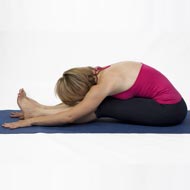Seated Yoga Mudra Pose
Owing to the widening awareness in Western medicine with regard to the body-mind-spirit connection, yoga is growing in interest. However, yoga should never be used to replace a particular treatment.
The best time to practice yoga is considered early in the morning, but you could also practice it in the evening if you are unable to find time in the morning. It is also essential for you to schedule a regular slot daily for your yoga workout.
Yoga mudra refers to various gestures in yoga that are performed with the hands. However, yoga mudra is also an advanced posture that is derived from Padmasana (Lotus Pose). The yoga mudra pose or the seated yoga mudra pose is known as the seal of yoga. This pose is considered important in the higher stages of yoga training for its spiritual value. The yoga mudra pose is held for more than an hour during this stage. This pose helps the body physically and spiritually through internal purification and detoxification.
About the yoga mudra pose
The yoga mudra pose is a perfect symbol of union. It is a pose of rest and passivity, which helps harmonize the psychic flow. You can use this pose to internalize your consciousness. When performing this pose, the spine is stretched, which brings about a release of tension, especially in the cervical and lumbar areas. At the same time, it provides a toning effect on the nerves of the spine. The pressure on the abdomen stimulates the organs of the abdomen and brings about peristalsis. The position of the hands held behind the back stretches out the chest region and increases the breathing capacity.
Steps
A step by step guide to the Yoga Mudra pose:
- Start by the cross-legged sitting position or sit on your feet with your buttocks resting on your heels. If you are sitting on your heels, extend your thighs out in front of you so that they are parallel to each other. The seated position you choose will depend on how comfortable you are and the state of your knees.
- Sit with your torso straight and be aware of your spine stretching as you extend your head to the ceiling.
- Clasp your hands behind you at the point of your lower back.
- Slowly start to lower your chest down to your thighs. Simultaneously, you should raise your hands so that the shoulders are stretched backwards.
- When you can no longer bend your torso, extend your arms overhead.
- Extend your arms upwards as if they are being stretched by invisible strings. However, while carrying out this maneuver, the chest remains in the same position.
- Let your awareness dwell on the stretch and remain in this pose for approximately five breaths.
- Then, gently get yourself back to the position you started off with.
Precautions
Avoid this pose if you suffer from, or have suffered from serious injuries to the back, heart, or eyes. You should also avoid this posture during any postoperative period and early post delivery. If you suffer from constipation, you should make practice this pose gently. You should always get out of this posture slowly without any sudden movements.
Beginner’s tip
A good beginner’s tip for yoga mudra pose is to practice this pose in Vajrasana (Thunderbolt Pose) or Ardha Padmasana (Half lotus Pose), if the practitioner is not able to perform the full Padmasana (Lotus Pose). This pose requires a lot of stability and flexibility in the joints of the ankles, knees, and hips, so make sure that you do not over stretch yourself, and hold the pose only for as long as you are comfortable.
Benefits to the body
The Yoga Mudra Pose benefits the body in the following ways:
- Helps in the toning and strengthening the body
- Strengthens the heart
- Separates each vertebrae of the spinal column from each other, thus increasing the flexibility of the backbone
- Strengthens abdominal muscles
Therapeutic Applications
The yoga mudra pose therapeutic applications are as follows:
- Abdominal distension is reduced
- Blood-related disorders can be managed
- Digestive function is improved
- Disorders related to the reproductive system can be treated
- Pancreas are stimulated, thus controlling diabetes
- Enhanced mental efficiency
- Better concentration
Variations
There are variations for yoga mudra pose if one is not able to perform the pose in the usual manner due to physical limitations.
- For beginners who find it difficult to touch the forehead to the ground, one could lower and raise the body a few times instead of holding onto the last position. The breathing should be adjusted accordingly.
- This next variation is for advanced practitioners who can easily touch the forehead to the ground. Perform the postures according to the usual instructions and inhale in the last position. Then, breathe out and bring the chin to the ground and try to push it away from the body. You can do this 2–3 times. Remember to breathe in when the body is still and breathe out when the chin is pushed away from the body.
Health benefits of a yoga-based diet
Along with the practice of the yoga pose, it is also essential that you follow a proper diet. To a yogi, not only is the quantity of food considered important, but also the way in which one eats the food. A yogic diet follows a pure or Sattvic diet. This is a balance of legumes, milk, cooked whole grains, vegetables, fresh fruit, seeds and nuts. It also uses a combination of cooked and raw foods. These foods raise the sattva in the body. They also increase our mental and physical vitality enabling us to experience peace of mind, lightness and clarity. According to yogic practice, when you eat, it is important to fill half the stomach with food; quarter of it should be left for liquids or water.
-
Health Benefits of Yoga Asanas -
The regular practice of yogasanas helps to keep us physically fit, reduces weight, normalizes blood pressure, controls stress and cholesterol levels and improve



